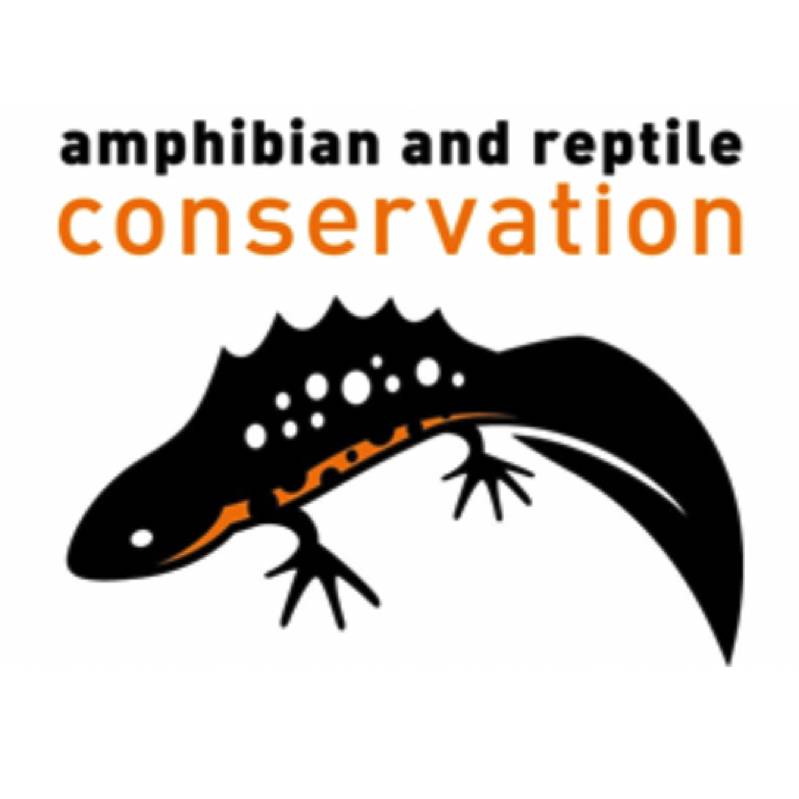Gaze into a clean pond on a sunny spring day and, if you are very lucky, you might just spot an orange and black flash undulating through the water. This is one of our largest and most charismatic amphibians, the great crested newt!
Also known as warty newts, these striking creatures are native to great Britain and our own populations are internationally important. This is because great crested newt are experiencing worrying declines across Europe, thought to be primarily due to loss of habitat. Read on to find out all about these flamboyant amphibians, how to recognise them, and what is being done to ensure their survival in our expert guide by Amphibian and Reptile Conservation.
To learn how you can make your garden pond more welcoming for species like the great crested newt, see our guide here.
What is the scientific name of the great crested newt?
The scientific name of the great crested newt is Triturus cristatus.
It is one of three native newt species found in the UK. The other two species are the smooth newt (Lissotriton vulgaris, sometimes known as a northern smooth newt or common newt) and palmate newt (L. helveticus). These two species used to belong in the Triturus genus with the great crested newt, but in 2004, scientists split the genus and created the Lissotriton genus, as well as the Ommatotriton and Icthyosaura genera. The Triturus genus still contains the crested newt and marbled newt species.
Where do great crested newts live?
Great crested newts have a widespread distribution throughout much of lowland England with a more restricted distribution in Wales and Scotland. The species is absent from Ireland. Significantly, the British great crested newt population is important at the European level, where the species is also experiencing declines.
As with our other native amphibians, the species requires both terrestrial and aquatic habitats, spending the majority of their life on land, migrating to ponds in the spring to breed. A wide range of habitats are used by the species including grassland, woodland (with a preference for deciduous woodland), scrub and mature hedgerows.
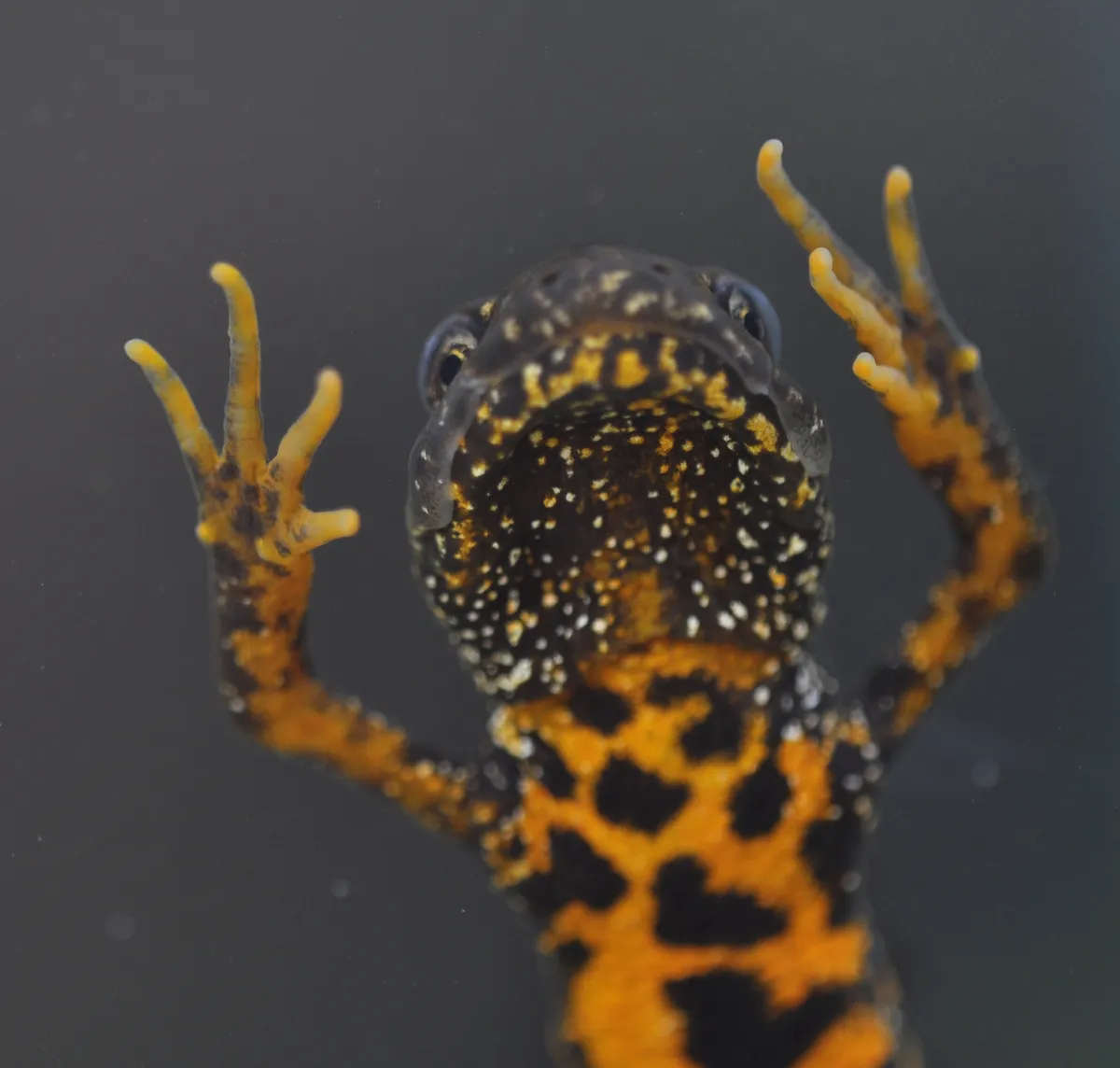
Aquatic habitats include ponds, ditches, ox-bow lakes and former mineral working sites (clay, stone workings etc.); this is where many of the largest newt populations are found.
Garden ponds are not typically used by the species as they tend to be too small, and great crested newts have more exacting requirements than smooth newts and frogs, but they can be found in some garden ponds– so if you have them in your pond consider yourself very lucky! Newts are also found in some more unusual water bodies including disused swimming pools and emergency water storage tanks on airfields.
How to identify great crested newts, smooth newts and palmate newts
This charismatic animal is the largest of our three native newts, both in length and width – and is very different from the smaller newts (palmate and smooth newts). Male great crested newts can grow up to about 15cm, with females reaching around 18cm in length (compared to 10cm and up to 9cm for smooth and palmate newts respectively).
Great crested newts look black or dark brown with obvious warts with white stippling on their flanks (giving rise to their other name of ‘warty newt’), as well as large black irregular spots, which extend onto their magnificent yellow-orange bellies.
Male great crested newts develop a striking jagged crest in the spring, running along the back, which dips and then continues onto the tail (but in a smoother fashion). The tail is also quite fleshy with an obvious blue or whitish flash in the centre, which is sometimes all you see of the animal when peering into a well vegetated pond at night.
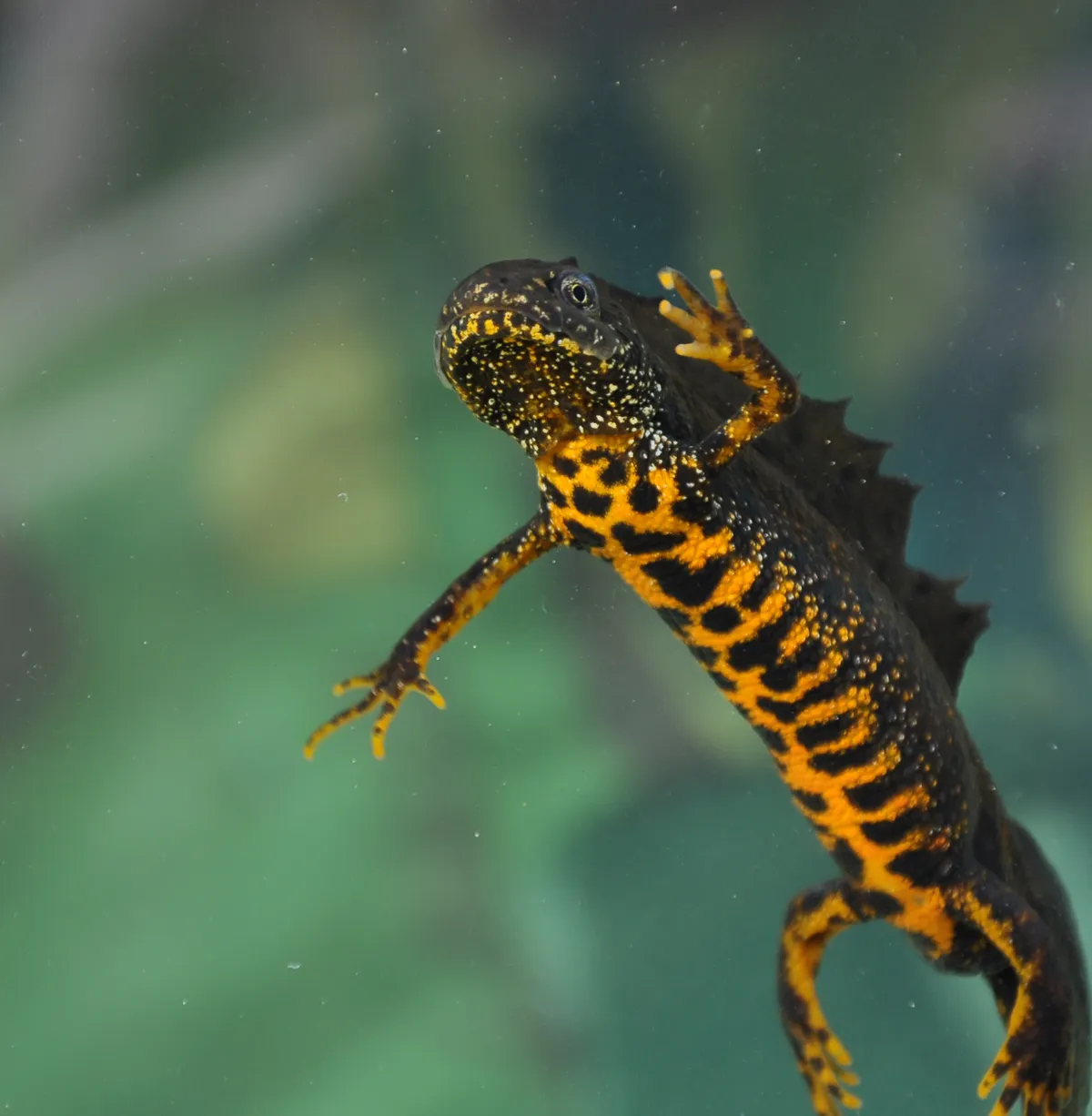
Females lack the crest of the male, but have a yellow/orange stripe running along the underside of the tail, and both sexes also have black and yellow stripy feet, so all in all this species is very distinctive.
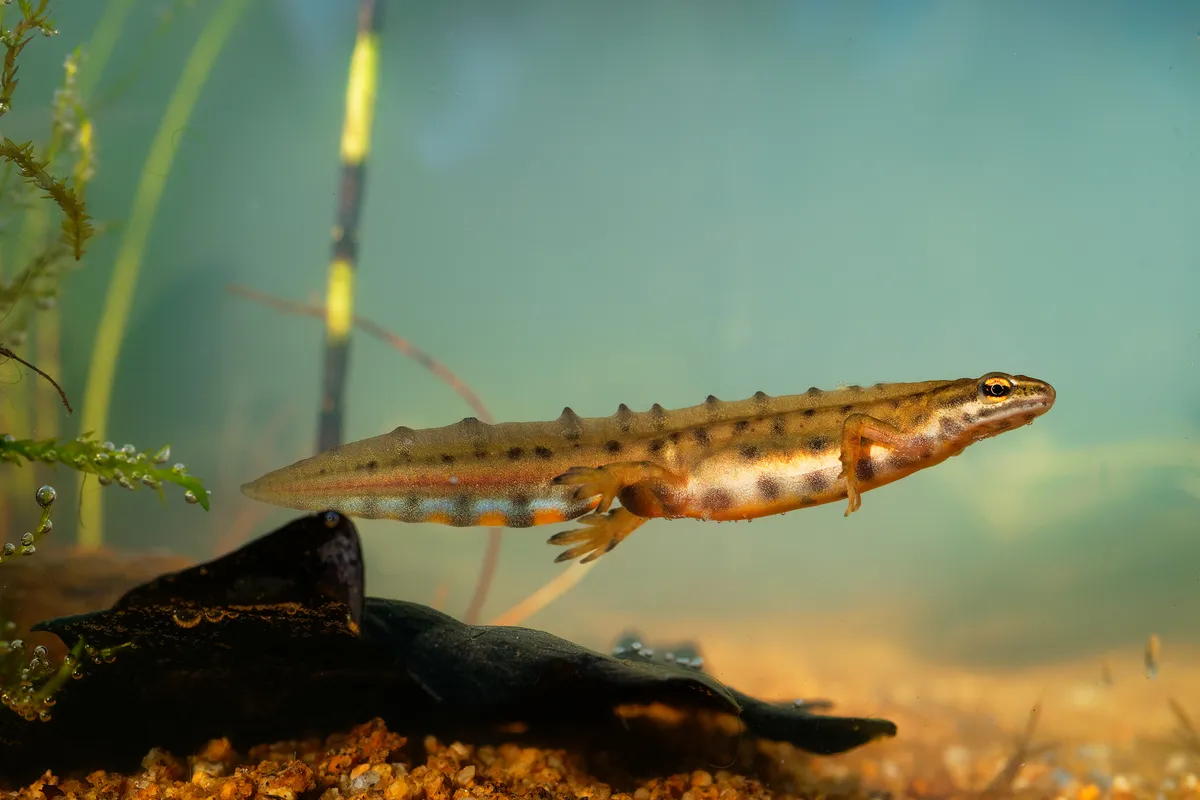
The smooth newt, our most common newt species in the UK, has a light brown/olive brown appearance; the male has a beautiful wavy, unbroken crest along the back continuing onto their tail. It is also very spotty, with round spots down the sides and on their orange undersides.
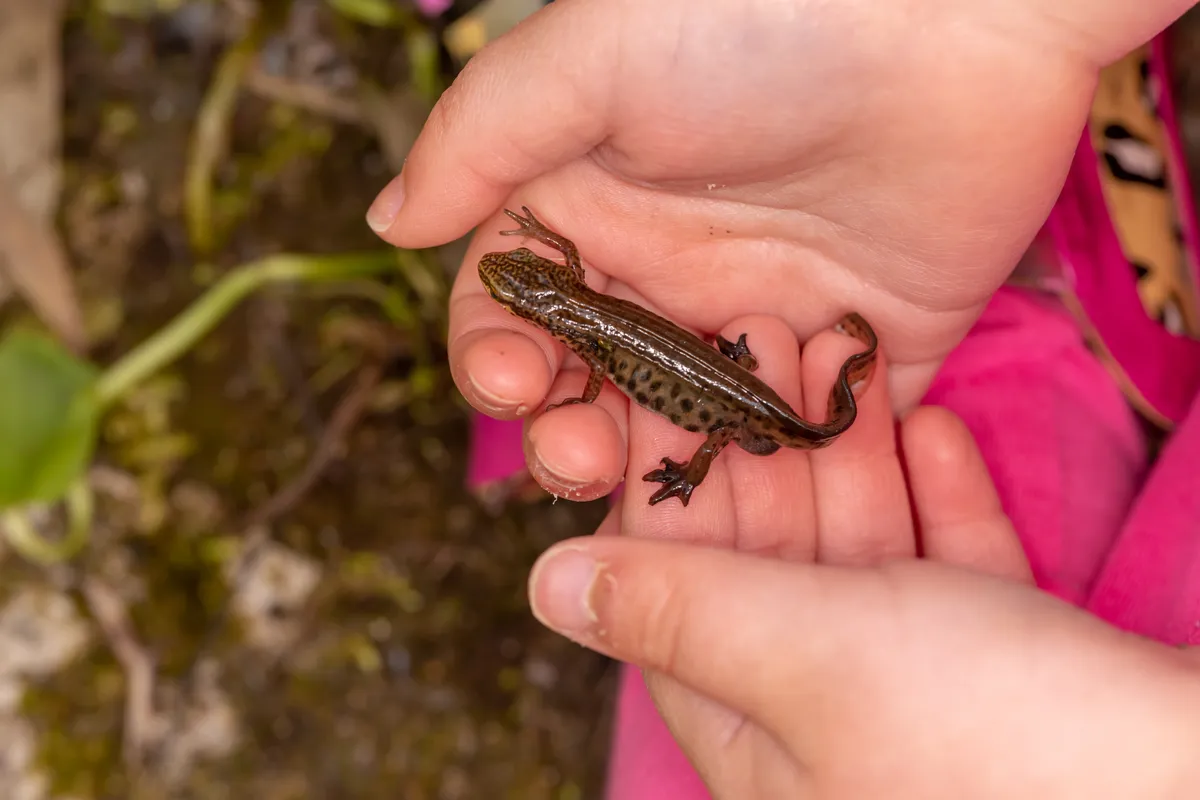
Similar in size and colour to the smooth newt, the palmate newt seems able to withstand dryer conditions than the smooth newt and are often found further from water during their terrestrial phase. It is absent from Ireland.
What do great crested newts eat?
Great crested newts are voracious predators, feeding on a wide range of invertebrates such as worms, snails, spiders, mites and springtails etc. when on land, and are known to try and eat prey that is far too large for them to manage.
When in the water, they eat a large selection of aquatic invertebrates such as mayfly nymphs, leeches, caddis fly, various larvae, freshwater shrimps, and they also eat frog tadpoles, frogspawn and even the smaller newts.
Prey is detected via sight and smell; movement of the prey captures their attention and they are able to move quickly through the water in order to secure their meal, but on land they are much slower.
Please note that external videos may contain ads:
Great crested newts compete to predate a smooth newt. © ARC
What eats great crested newts?
Adult great crested newts are preyed on by quite a range of animals, including birds such as herons and buzzards, snakes, badgers and hedgehogs. Adults do have some defence against predation; their warty skin contain toxins, and when they feel threatened they are able to take up postures which show their striking black and yellow underside as a warning to potential predators.
Great crested newt larvae are readily preyed upon as they swim in the open water, and are taken by large dragonfly nymphs, water beetles, other newts and fish.
Do great crested newts lay eggs?
Great crested newt courtship is complex, with the male displaying to a female in an elaborate way, in an open area of the pond, generally in the shallows, during April and May.
After mating, female great crested newts will lay somewhere in the region of 250 eggs in a season. This is a painstaking process with the female selecting a suitable submerged leaf, using her back feet to fold the leaf, laying the egg and then sealing the leaf, again with her back feet.
A sticky substance is produced around the egg which helps to keep the leaf together, affording the egg some protection. Aquatic plants such as water forget-me-not, water cress, floating sweet grass, and water mint are often favoured for egg laying, but other substrates can be used where suitable plants are absent, including dead leaves and even crisp packets!
Do great crested newts hibernate?
Great crested newts hibernate over winter, typically from November through to February. At this time, the majority of newts will be terrestrial, hunkered down in frost-free places such as below ground in mammal tunnels, deep in soil, or in voids in banks, under suitable log piles etc. Some newts (including juveniles) will over-winter close to breeding ponds, if the habitat is suitable, whilst a smaller proportion may stay at the bottom of ponds.
What threats do great crested newts face?
Many of the threats facing great crested newts are familiar to many other species, that of habitat loss (both ponds and terrestrial habitats), and habitat fragmentation, due to development and associated infrastructure and agriculture. The species is particularly vulnerable to these changes due to its reliance on both terrestrial and aquatic habitats. Great crested newts also have more exacting pond requirements, so typically has not been able to take advantage of garden ponds like smooth newts and frogs, for example.
Ponds are also being lost due to natural succession and neglect, where management is needed to open them up by removing shading vegetation, and clear out excessive amounts of silt, helping to retain a network of ponds in the landscape for newts and other pond inhabitants. This needs to be undertaken sensitively and take account of other protected species which could be present in these late successional stage ponds. Other key threats include the introduction of fish into ponds, bad news for pond wildlife, but the warty newt is particularly susceptible as their larvae spend their time out in the open water, and not amongst vegetation like the smaller newt species. Disease and the effects of climate change are also of great concern.
Due to the species suffering from severe declines, the great crested newt is strictly protected in law.
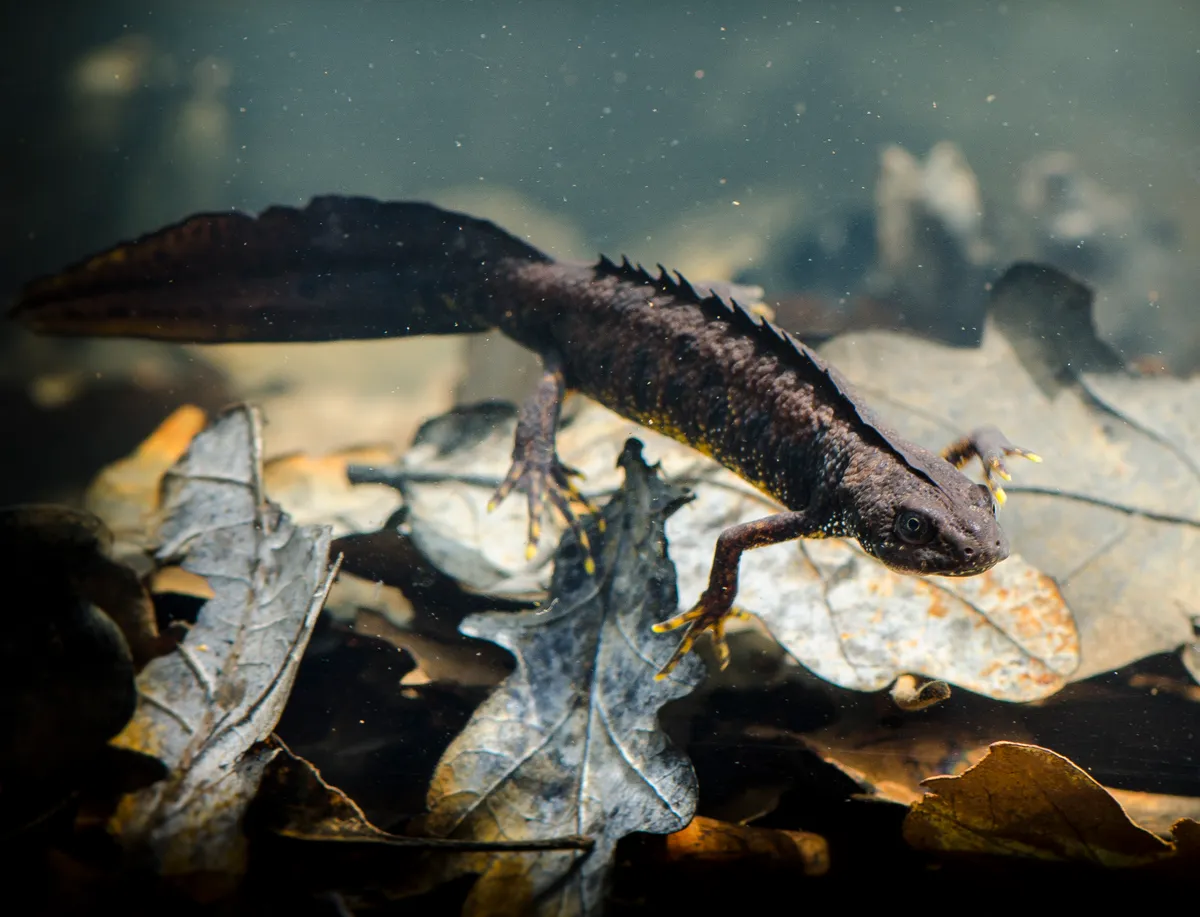
What is being done to help great crested newts?
As a widespread species, great crested newts need both practical action and improved policy, such as agriculture and water policy, to have the greatest impact. Amphibian and Reptile Conservation works to make policy more favourable to great crested newts by engaging with government, housing developers and other stakeholders.
Amphibian and Reptile Conservation manages reserves supporting great crested newts, and helps other landowners improve their land for this species. Regional projects run by Amphibian and Reptile Conservation, such as Connecting the Dragons in South Wales, engage local people in the conservation of great crested newts, as well as making a practical difference to local habitats. The organisation also provides guidance, advice and training courses on great crested newt conservation.
Amphibian and Reptile Conservation (ARC) is a wildlife charity committed to conserving amphibians and reptiles, and saving the disappearing habitats on which they depend.
Main image: Great crested newt. © Chris Dresh/Amphibian and Reptile Conservation Trust
